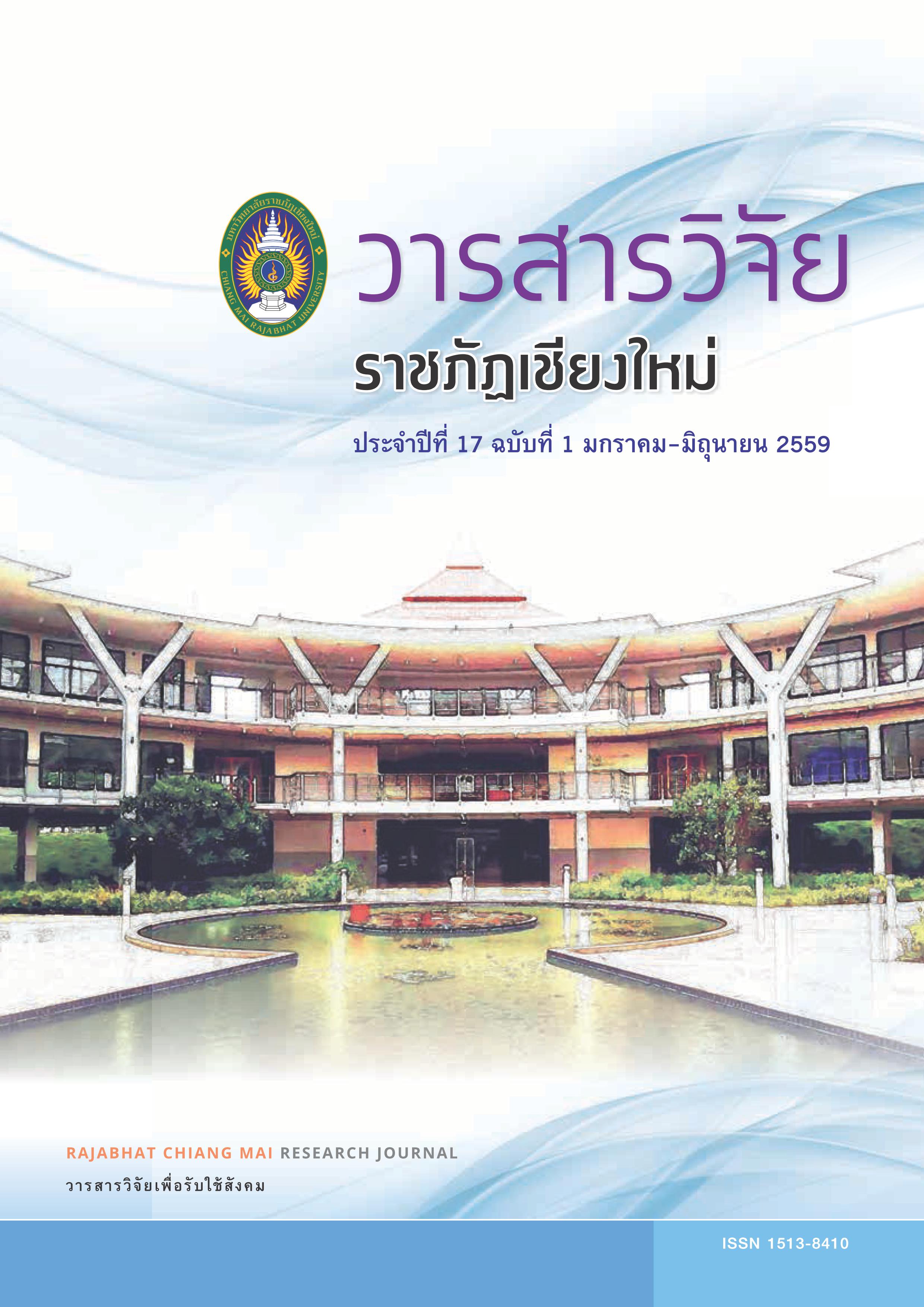การจัดการเรียนรู้เชิงรุกสำหรับครูชาวต่างชาติที่มีต่อการเรียนภาษาอังกฤษของนักเรียนไทย
DOI:
https://doi.org/10.14456/rcmrj.2016.214977คำสำคัญ:
การจัดการการเรียนรู้เชิงรุก, ครูผู้สอนชาวต่างชาติ, การเรียนภาษาอังกฤษของนักเรียนไทยบทคัดย่อ
การวิจัยครั้งนี้มีวัตถุประสงค์เพื่อศึกษาระดับการจัดการเรียนรู้เชิงรุก (Active Learning Management) ของครูผู้สอนภาษาอังกฤษชาวต่างชาติในโรงเรียนเอกชนชั้นมัธยมศึกษาปีที่ 3 ในจังหวัดเชียงใหม่ และลำพูน พัฒนาคู่มือแนวทางการจัดการเรียนรู้วิชาภาษาอังกฤษระดับชั้นมัธยมศึกษาปีที่ 3 ในรูปแบบการเรียนรู้เชิงรุก และเปรียบเทียบผลของการเรียนรู้เชิงรุกที่มีต่อการเรียนรู้ภาษาอังกฤษของนักเรียนโรงเรียนเอกชนชั้นมัธยมศึกษาปีที่ 3 ในจังหวัดเชียงใหม่ และลำพูน ประชากรที่ใช้ในการวิจัยครั้งนี้คือ โรงเรียนเอกชนที่รับเงินอุดหนุนจากรัฐ (ยกเว้นโรงเรียนที่เป็นมูลนิธิ) ระดับชั้นมัธยมศึกษาปีที่ 3 ในจังหวัดเชียงใหม่ 23 โรงเรียน และจังหวัดลำพูน 3 โรงเรียน ผู้วิจัยได้สำรวจโรงเรียนที่ประสงค์เข้าร่วมกิจกรรม ได้มาทั้งหมด 5 โรงเรียน จากนั้นกำหนดให้ เป็นกลุ่มทดลอง 3 โรงเรียน และกลุ่มควบคุม 2โรงเรียน ใช้การวิจัยแบบกึ่งทดลอง เก็บรวบรวมข้อมูลโดยใช้ แบบสำรวจ แบบสอบถาม คะแนนสอบระหว่างภาค คะแนนสอบปลายภาค คะแนนทดสอบก่อนและหลังการทดลอง ผลการวิจัย พบว่า 1) ครูโรงเรียนกลุ่มทดลองมีการใช้รูปแบบการเรียนรู้เชิงรุกเพิ่มขึ้น 2) คะแนนภาษาอังกฤษของโรงเรียนกลุ่มทดลองและกลุ่มควบคุมมีผลที่มีนัยสำคัญทางสถิติที่ระดับ 0.05 ดังนี้ (1) ก่อนการทดลอง คะแนนภาษาอังกฤษของโรงเรียนกลุ่มทดลองและโรงเรียนกลุ่มควบคุมมีค่าไม่แตกต่างกัน (2) สำหรับกลุ่มทดลอง คะแนนหลังการทดลองสูงกว่าก่อนการทดลอง (3) คะแนนที่เพิ่มขึ้น (หลัง-ก่อน) ของโรงเรียนกลุ่มทดลองสูงกว่ากลุ่มควบคุม
Downloads
เอกสารอ้างอิง
ศูนย์ข้อมูลความรู้ประชาคมเศรษฐกิจอาเซียน. 2558. 8 วิชาชีพ อ่อนภาษา-ไอที. (ระบบออนไลน์). แหล่งข้อมูล: http://www.thai-aec.com/728 (8 เมษายน 2558)
สำนักงานเลขาธิการสภาการศึกษา. 2552. ข้อเสนอการปฏิรูปการศึกษาในทศวรรษที่สอง (พ.ศ. 2552-2561). กรุงเทพฯ: พริกหวานกราฟฟิค.
มหาวิทยาลัยธรรมศาสตร์ คณะสถาปัตยกรรมศาสตร์และผังการเมือง หน่วยวิจัยเมือง. 2554. เชียงใหม่: บ้านหลังสุดท้ายของชาวต่างชาติ. (ระบบออนไลน์). แหล่งข้อมูล: http://www.cityresearchunit.org/th/files/chiangmai_creative_city/เชียงใหม่ บ้านหลังสุดท้ายของชาวต่างชาติ.pdf (22 กันยายน 2556)
องอาจ นัยพัฒน์. 2551. วิธีวิทยาการวิจัยเชิงปริมาณและเชิงคุณภาพ ทางพฤติกรรมศาสตร์และสังคมศาสตร์. พิมพ์ครั้งที่ 3. กรุงเทพฯ: สามลดา.
Alemu, B. M. 2010. Active Learning Approaches in Mathematics Education at Universities in Oromia, Ethiopia. Doctoral Thesis, University of South Africa.
Bonwell, C., & Eison, J. 1991. Active Learning: Creating Excitement in the Classroom (ASHE-ERIC Higher Education Report No.1). Washington, DC: George Washington. University. Jossey- Bass. (online). Retrieved from: http://www.ed.gov/databases/ERIC_Digests/ed340272.html (March 25th, 2013)
Dale, E. 1946. Audio-visual methods in teaching. New York: The Dryden Press.
Geressu, T. 2008. Perceptions and Practices of Active Learning in EFL Classes of Dilla University. Master Thesis, Addis Ababa University.
Howard, J. 2003. Academic Service-Learning: A Counternormative Pedagogy. In C. Compact (Ed.), Introduction to Service-Learning Toolkit: Reading and Resources for Faculty 2nd Edition. Rhode Island: Providence.
Laurin, R. K. 2009. Perceptions of Active Learning Techniques for Diversity Training in an Academic and Professional Settings: A Wisconsin Case Study. Master Thesis, The University of Wisconsin-Whitewater.
McKeachie, W. 2002. Teaching Tips: Strategies, Research, and Theory for College and University Professors. Boston, MA: Houghton Mifflin.
Meyer, C., & Jones, T. B. 1993. Promoting Active Learning: Strategies for the College Classroom. San Francisco: Jossey-Bass.
Mijena, A. E. 2015. The Practice of Active Learning Methods in English Language Classroom in Some Selected Secondary School of Jardega Jarte Woreda. Master Thesis, Haramaya University.
Robertson, D. R. 2005. Generative Paradox in Learner-Centred College Teaching. Innovation of Higher Education, 29(3): 181-194.
Standridge, M. 2002. Emerging Perspectives on Learning, Teaching, and Technology. (online). Retrieved from: http://projects.coe.uga.edu/epltt/ (September 8th, 2013)
ดาวน์โหลด
เผยแพร่แล้ว
รูปแบบการอ้างอิง
ฉบับ
ประเภทบทความ
สัญญาอนุญาต
1. บทความ ข้อมูล เนื้อหา รูปภาพ ฯลฯ ที่ได้รับการตีพิมพ์ใน “Community and Social Development Journal” ถือเป็นลิขสิทธิ์ของ Community and Social Development Journal มหาวิทยาลัยราชภัฏเชียงใหม่ และเพื่อให้เผยแพร่บทความได้อย่างเหมาะสมผ่านสื่อสิ่งพิมพ์และอิเล็กทรอนิกส์ ผู้เขียนยังคงถือครองลิขสิทธิ์บทความที่ตีพิมพ์ภายใต้ใบอนุญาต Creative Commons Attribution (CC BY) ซึ่งอนุญาตให้เผยแพร่บทความซ้ำในแหล่งอื่นได้ โดยอ้างอิงต้องอ้งอิงบทความในวารสาร ผู้เขียนต้องรับผิดชอบในการขออนุญาตผลิตซ้ำเนื้อหาที่มีลิขสิทธิ์จากแหล่งอื่น
2. เนื้อหาบทความที่ปรากฏในวารสารเป็นความรับผิดชอบของผู้เขียนบทความโดยตรง ซึ่งกองบรรณาธิการวารสารไม่จำเป็นต้องเห็นด้วยหรือร่วมรับผิดชอบใดๆ














